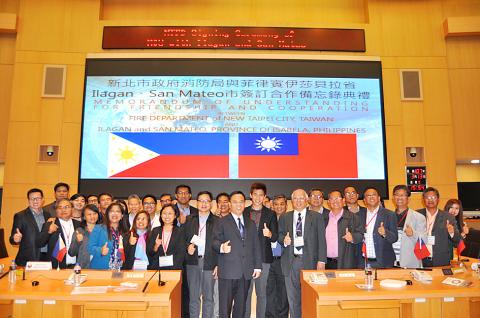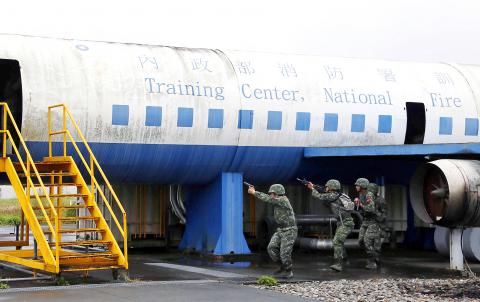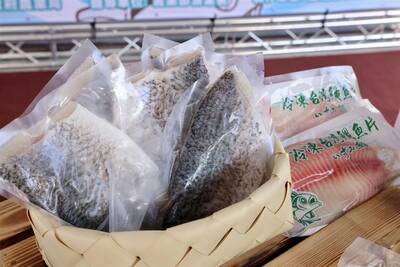“Taiwan can help,” National Fire Agency (NFA) Deputy Director-General Hsiao Huan-chang (蕭煥章) said, quoting a government slogan that offers Taiwan’s expertise and experience in a number of fields to the world.
These are not just empty words to garner international support: Countries, especially in the Indo-Pacific region, have been eager to learn from Taiwan’s advancements in disaster relief and emergency management at the NFA’s training center in Nantou County’s Zhushan Township (竹山).
“More natural and disasters of human origin are happening in the world due to global warming and climate change,” Hsiao said. “Every country has to consider how they would deal with them.”

Photo: CNA
Covering 109 hectares, the training center is the third-largest in the world and the largest in Asia.
The main complex was expanded in 2017 specifically for the goal of increasing international exchanges with countries covered by the New Southbound Policy. It boasts a comprehensive list of simulation grounds for a wide range of scenarios, from ship fires to collapsed buildings to plane crashes.
The training center also showcases Taiwan’s state-of-the-art equipment to its visitors.

Photo: CNA
One of the New Southbound Policy’s goals is to generate more business opportunities for Taiwanese firms in those countries.
The best way to achieve that is to let the visitors experience the equipment firsthand during training exercises, Hsiao said, adding that there has already been significant interest from Vietnam and other countries.
In addition to hands-on training, the center also produces teaching materials in accordance with international standards that focus on strategic planning and management, he said.
“We are preparing everything based on the simple principle that each life is priceless,” Hsiao said.
From typhoons and earthquakes to dust explosions and transportation accidents, Taiwan has seen its fair share of disasters in the past few decades, most notably the devastating 921 Earthquake in 1999.
The training center was created in response to that earthquake to enhance Taiwan’s capabilities in dealing with disasters and to share its experience with other nations so that they can avoid the same mistakes.
As South Asia and Southeast Asia are prone to disasters such as earthquakes and floods, the NFA has been providing increased disaster prevention and relief training to the area under the New Southbound Policy, with the goal of strengthening the region’s mutual aid network.
Disaster relief has always been an international effort, Hsiao said, adding that it only makes sense for Taiwan to ramp up its cooperation in the region.
“There are no boundaries for firefighting or emergency management,” Hsiao said.
The center has enjoyed close ties with the Philippines since its inauguration in 2010, as members of Philippine volunteer fire brigades from overseas Chinese communities train there annually.
Thirty-two firefighters from 15 cities in April made the trip to participate in a week-long training program that included vehicle extrication, fire equipment, fire control and first aid.
The firefighters told the media that they learned skills and about equipment not available in the Philippines, including the use of a self-contained breathing apparatus.
In July last year, the government announced that the training would be extended to professional Philippine firefighters.
Exchanges between the two nations have increased since, with delegations from the Philippines’ National Fire Training Institute, as well as government officials, visiting the facility.
The Philippine government has in turn invited the NFA to share its experience with its counterparts in Manila.
Taichung has been one of the most active municipalities in reaching out to New Southbound Policy countries.
In May, the Taichung City Government hosted a delegation from the Philippine Department of the Interior and Local Government, whose members came specifically to learn about the city’s disaster prevention mechanisms, while discussing avenues for mutual cooperation.
In March 2017, the Taichung City Government hosted a joint training event with firefighters from Vietnam’s Binh Duong Province.
Immediately north of Ho Chi Minh City, the province ranks third in Vietnam in foreign direct investment, with Taiwan being the top investor at 841 projects worth US$5.5 billion as of last month.
For the 20th anniversary of the 921 Earthquake, Taichung has invited firefighters from its sister city of Auckland who helped with recovery efforts for a tour and presentation.
Taiwan’s capabilities in humanitarian assistance and disaster relief have caught the attention of the US, which is working with the NFA through the American Institute in Taiwan (AIT) to establish Taiwan as a training center for the Asia-Pacific region.
Through the Global Cooperation and Training Framework initiative launched in 2015, Taiwan and the US cohosted their first international workshop at the NFA’s training center in July 2017.
Six guest countries participated, including Thailand, the Philippines and Malaysia, which are some of the nations the New Southbound Policy focuses on.
The most recent workshop took place in December last year, with 10 Indo-Pacific countries participating.
In his opening remarks, AIT Deputy Director Raymond Greene called Taiwan a “model of disaster preparedness in the region” and lauded its willingness to assist other nations over the past decade.
Another of Taiwan’s strengths lies in hazardous materials incident prevention and management, Hsiao said.
Through collaboration with the Environmental Protection Administration’s Toxic and Chemical Substances Bureau and National Yunlin University of Science and Technology, the NFA has been carrying out hazardous materials first responder operations training for South Asian and Southeast Asian countries over the past three years.
The latest event last month welcomed 22 students from Vietnam, Indonesia, India and Pakistan, and another workshop in November is to cater to government officials, academics and professionals from countries in the two regions.
Taiwan is also becoming known for is swift water rescue capabilities, Hsiao said, which is also crucial for the policy, as South Asia and Southeast Asia are some of the most flood-prone regions in the world.
The training center boasts an artificial river capable of simulating swift currents, large open-water areas and short drops, and has been training instructors in this field from across Asia.
After the Binh Duong Province training session, Hsiao said that the Vietnamese firefighters were highly impressed by Taiwan’s firefighting suits, helmets and gloves, and inquired about purchasing them.
Another technology that has garnered international interest is the center’s updated Emergency Management Information Cloud system, a smart information system that provides vital information about natural disasters and accidents of human origin to the public, as well as responders, Hsiao said.
For example, it can notify the government which areas are prone to mudslides before a typhoon hits so that residents can be evacuated beforehand, he said.
As disaster relief involves multiple agencies and facilities, the system can also immediately provide accurate data to responders on relevant and available resources based on the type and location of the disaster, he added.
During the Philippine fire institute delegation’s visit, the Bureau of Foreign Trade invited several Taiwanese firms to present their wares, including standard equipment, as well as high-tech products such as an earthquake warning system, a smart dynamic evacuation system and a smart disaster prevention command system that uses artificial intelligence and Internet of Things technology.
The Fire & Safety Expo in May also prioritized providing smart and high-tech solutions targeting the needs of New Southbound Policy countries.
International rescue competitions are another area in which Taiwan can make its disaster relief prowess known.
In May last year, seven firefighters won an award for outstanding excellence at the Extraction Challenge in France.
The Kaohsiung Rope Rescue Team in June took first place at the Grimpday rescue competition in Belgium, beating 30 teams from 15 nations.
“This is more than just about winning or losing,” one team member said. “We want Taiwan to be seen.”

Taiwan's Vice President Hsiao Bi-khim (蕭美琴) said Saturday that she would not be intimidated by the Chinese Communist Party (CCP), following reports that Chinese agents planned to ram her car during a visit to the Czech Republic last year. "I had a great visit to Prague & thank the Czech authorities for their hospitality & ensuring my safety," Hsiao said on social media platform X. "The CCP's unlawful activities will NOT intimidate me from voicing Taiwan's interests in the international community," she wrote. Hsiao visited the Czech Republic on March 18 last year as vice president-elect and met with Czech Senate leadership, including

There have been clear signs of Chinese Communist Party (CCP) attempts to interfere in the nationwide recall vote on July 26 in support of Chinese Nationalist Party (KMT) legislators facing recall, an unnamed government official said, warning about possible further actions. The CCP is actively involved in Taiwanese politics, and interference in the recall vote is to be expected, with multiple Chinese state media and TAO attempts to discredit the Democratic Progressive Party (DPP) and undermine public support of their recall movement, the official said. This interference includes a smear campaign initiated this month by a pro-Beijing Hong Kong news outlet against

A week-long exhibition on modern Tibetan history and the Dalai Lama’s global advocacy opened yesterday in Taipei, featuring quotes and artworks highlighting human rights and China’s ongoing repression of Tibetans, Hong Kongers and Uighurs. The exhibition, the first organized by the Human Rights Network for Tibet and Taiwan (HRNTT), is titled “From the Snowy Ridges to the Ocean of Wisdom.” “It would be impossible for Tibetans inside Tibet to hold an exhibition like this — we can do it. because we live in a free and democratic country,” HRNTT secretary-general Tashi Tsering said. Tashi Tsering, a Taiwan-based Tibetan who has never

A first shipment of five tons of Taiwan tilapia was sent from Tainan to Singapore on Wednesday, following an order valued at NT$600,000 (US$20,500) placed with a company in the city. The products, including frozen whole fish and pre- cooked fish belly, were dispatched from Jiangjun Fishing Harbor, where a new aquatic processing and logistics center is under construction. At the launch, Tainan Mayor Huang Wei-che (黃偉哲) called the move a “breakthrough,” marking Taiwan’s expansion into the Singaporean tilapia market. Taiwan’s tilapia exports have traditionally focused on the United States, Canada, and the Middle East, Huang said, adding that the new foothold in